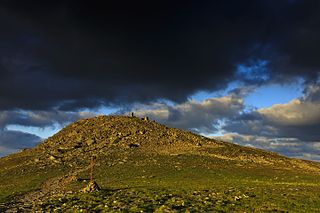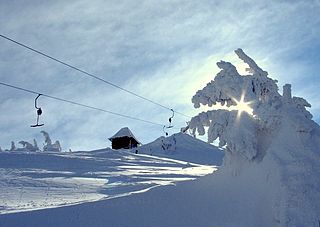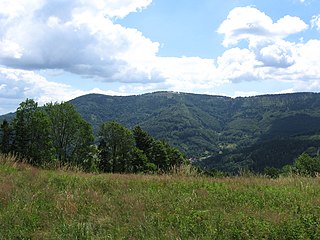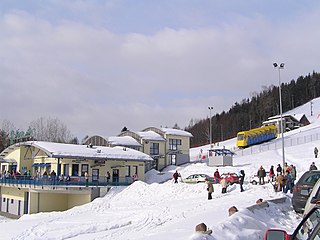
The Beskids or Beskid Mountains are a series of mountain ranges in the Carpathians, stretching from the Czech Republic in the west along the border of Poland with Slovakia up to Ukraine in the east.

Divisions of the Carpathians are a categorization of the Carpathian mountains system.

Chornohora is the highest mountain range in Western Ukraine. It is within the Polonynian Beskids, a subgroup of the mountain group of Eastern Beskids, which in turn is part of the Outer Eastern Carpathians.

Babia Góra National Park is one of the 23 national parks in Poland, located in the southern part of the country, in Lesser Poland Voivodeship, on the border with Slovakia. Its headquarters are located in Zawoja. A Nature Reserve which roughly covered the area of the modern-day national park was created in 1933, with the actual park established on October 30, 1954. Since 1976, it has been designated by UNESCO as a biosphere reserve.

The Lemko Region is an ethnographic area in southern Poland and Northern Eastern Slovakia that has traditionally been inhabited by the Lemko people. The land stretches approximately 140 km (87 mi) long and 25–50 km (16–31 mi) wide along the north side of the Carpathian Mountains, following the Polish-Slovak border from the Poprad River. In the East, the region is described as either terminating linguistically between the Wisłok and Osława Rivers, or ethnographically at the Sanok River, where it meets the Boyko region. Some even go so far as to consider it to extend south into the Prešov Region, Slovakia.

Silesian Beskids is one of the Beskids mountain ranges in the Outer Western Carpathians in southern Silesian Voivodeship, Poland and the eastern Moravian-Silesian Region, Czech Republic.

The Little Beskids is one of the Beskids mountain ranges in the Western Beskids ranges of the Outer Western Carpathians in southeastern Poland. Within the range is the protected area known as Little Beskids Landscape Park.

Pilsko is the second highest mountain of the Żywiec Beskids mountain range, near the border between Poland and Slovakia. It rises to an altitude of 1,557 meters (5,108 ft) and is a hiking destination in summer and a skiing area in winter. The name Pilsko is frequently used not only to describe the main peak, which lies in Slovakia, but also the whole range. The mountain lies not only on the border between the two nations, it also marks the European Watershed.

Polica, locally known as Police, is a mountain, 1,369 m (4,491 ft), in southern Poland near Zawoja, in the Żywiec Beskids mountain range.

Little Beskids Landscape Park is a protected area in southern Poland, established in 1998, covering an area of 257.7 square kilometres (99.5 sq mi). It lies within the Little Beskids mountain range. Its highest peak is Czupel, at 933 metres (3,061 ft).

The Alishan Range is a mountain range in the central-southern region of Taiwan. It is separated by the Qishan River from the Yushan Range, the tallest range in Taiwan, to the east of the Alishan Range. The highest peak of the Alishan Range is Datashan (大塔山), which has a height of 2,663 m (8,737 ft). There is a famous Taiwanese song called "Alishan de Guniang" which is about a girl in the Alishan mountains. The name Ali Shan seems to be taken from the word "Alit", which in several Taiwanese indigenous languages means "ancestor mountain".

Trzy Korony is the summit of the Three Crowns Massif, an independent portion of a range called Pieniny Mountains in the south of Poland. Trzy Korony forms the central part of a compact group of connected mountains known as Pieniny Środkowe, consisting mainly of the limestone and dolomite rock strata. Trzy Korony is located within the Pieniny National Park in Lesser Poland Voivodeship.

The Western Beskids are a set of mountain ranges spanning the Czech Republic, Slovakia, and Poland. Geologically the Western Beskids are part of the Outer Western Carpathians.

Oravské Beskydy is a range of mountains straddling the northern-Slovakia-southern-Poland border, considered part of the Central Beskids, within the Outer Western Carpathians.

Central section of the Western Beskids are a set of mountain ranges spanning the southern Polish and northern Slovak border. They constitute a section of the Western Beskids, within the Outer Western Carpathians.

The Island Beskids is a mountain range in southern Poland, part of the Western Beskids of the Outer Western Carpathians, with significant natural resources, folk culture, medieval history, and developing resources for tourism.

Żar is a mountain in the mountain range of Little Beskids in southern Poland, 761 m above the sea level.

Beskid Dukielski is the middle part of the Low Beskids mountain range, lying north of the Dukla Pass and being named after the town of Dukla.

The Kazmierz Sosnowski Main Beskid Trail is a long-distance trail marked in red that leads from Ustroń in the Silesian Beskids to Wołosate in the Bieszczady Mountains.




















